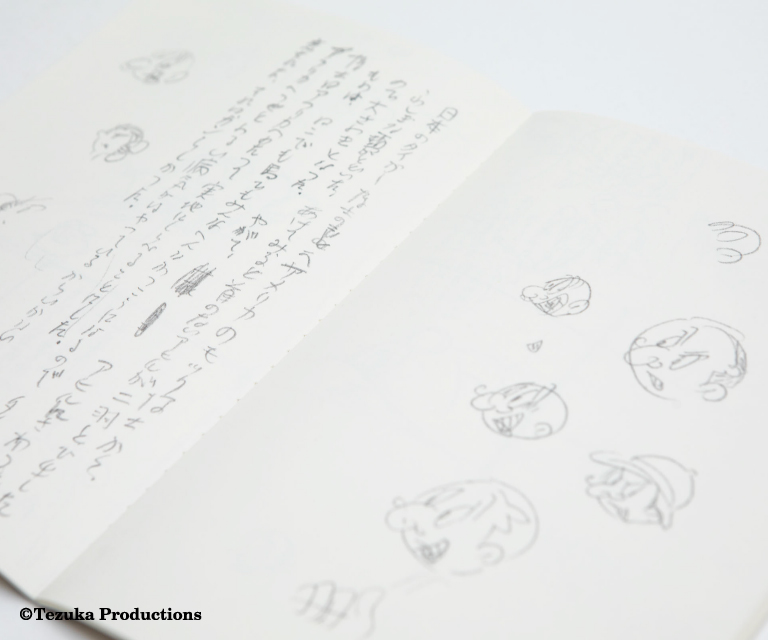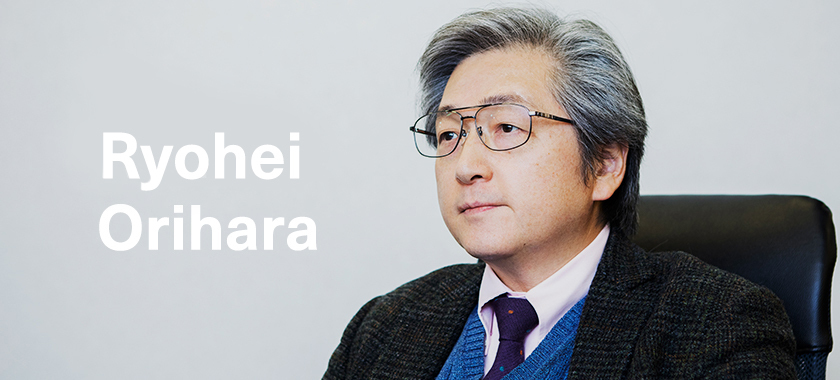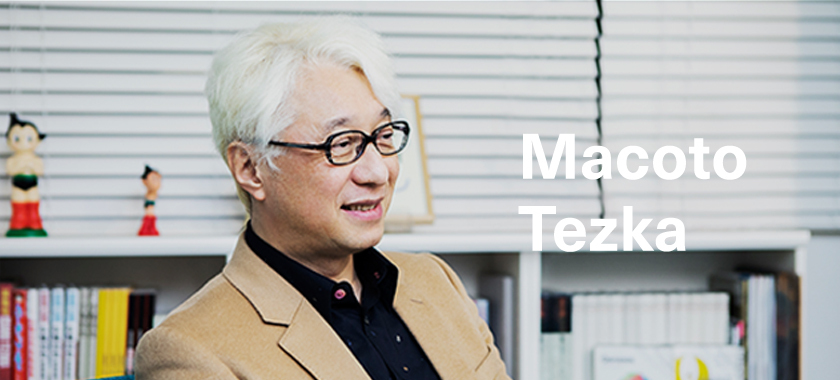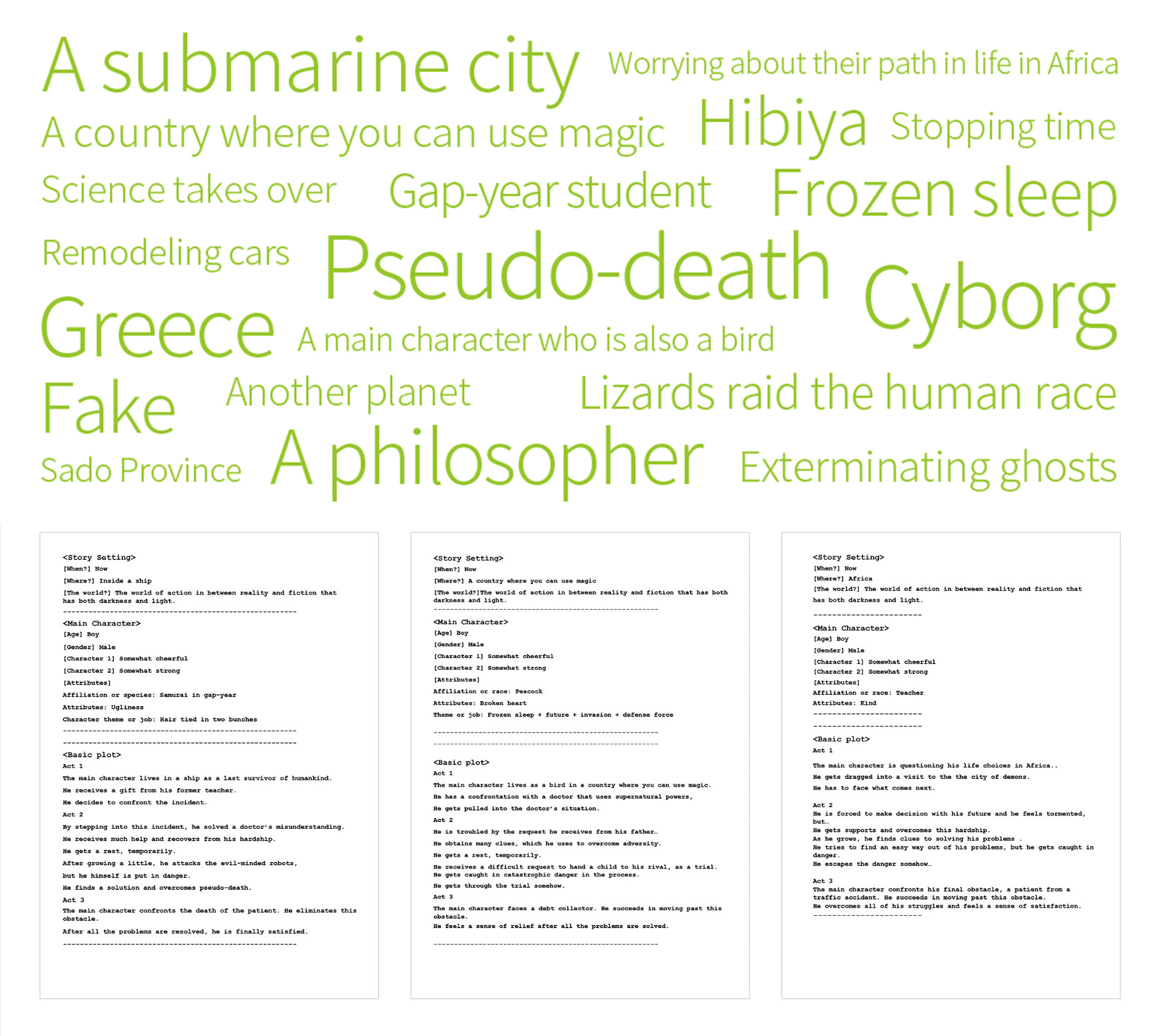
What is science, the future, and freedom?
Osamu Tezuka drew the universal theme of human existence.
We took on the challenge of his overwhelming imagination.
- TEZUKA2020 VOL.3 Story -
If there is one thing that Osamu Tezuka and AI have in common, it is the ability to make a great leap of imagination in a positive sense. Eccentric ideas that would normally be unthinkable come about one after another. In creating the story of “TEZUKA 2020”, AI’s inspiration became the “seeds of the plot” and bore fruit in the form of “PHAEDO”.
Osamu Tezuka and his world that everyone dreamed of?

KIOXIA Corporation – Senior Fellow Digital Process Innovation Center
The work of Osamu Tezuka left a mark in people’s memories across many generations.
The impact of his work motivated us to start this project.
FUTURE MEMORIES 01 “TEZUKA 2020” is a project where AI and humans create a piece of work from Osamu Tezuka’s many memories. Mr. Orihara, who served as the leader of the project, talks about why he started the project.
“I thought about the keyword “FUTURE MEMORIES”. What would be a new memory generated by existing memories of people? The first thing I thought of was manga.”
Manga has become well-known as a manifestation of Japanese culture around the world, and it is read and loved across generations. The challenge of generating it by artificial intelligence excited the grown-ups in the project. But why did it have to be Osamu Tezuka?
“The answer is very simple. Just as the anniversary of his death is “Manga day”, manga equals Osamu Tezuka. If you ask people, especially those who are over 40 years old, what the first manga or anime they encountered was, the majority would say Osamu Tezuka’s works. Even me—I didn’t read that much manga through my life, but yes, my first manga was a Tezuka’s. I cannot forget the grand worldview of “Phoenix”, which I read when I was a junior high school student.”
The project is worth doing because Osamu Tezuka’s works left an impression on so many people. Mr. Orihara comments that he aimed to “create manga that could be appreciated as a new Tezuka Osamu work, using the data from his manga.”
“Honestly, it would be very difficult to realize it just by AI, with the technology we have right now. Therefore, the AI and humans need to work together. What we expected from AI this time was to provide the seeds of inspiration to manga artists. The manga needs settings for storylines and characters as a starting point, and AI took the role to provide them.”
Ryohei Orihara
KIOXIA Corporation – Senior Fellow Digital Process Innovation Center
An expert in AI, he has researched the topic for 34 years and counting since he was in graduate school. In 1988, he graduated with an MA from the University of Tsukuba, majoring in Information Sciences and Electronics. After working for Toshiba Corporation and Toshiba Memory Corporation, he is now the Engineer in Chief for the Digital Process Innovation Center at Kioxia Corporation. He has researched the use of technology to support creativity, machine learning, and data text mining. A work by Osamu Tezuka that left an impression to him is “Phoenix: Future”.
What are “Tezuka-like” lines?

Director of Tezuka Productions, Visualist
Normally unthinkable scenarios can happen in Tezuka’s works.
His stories examine the nature of humanity on a deep level.
Mr. Macoto Tezka, who has watched Osamu Tezuka more closely than anyone, says that his stories are unique because of their “unexpectedness”.
“Osamu Tezuka can come up with story settings that other people cannot usually imagine. He was always observing mountains, plant life, and humans as all being part of nature, and he put what he learned into the story. That is the vision of “Osamu Tezuka”. From his own place in time, he would imagine what the world was like 100 years ago, or 1000 years ago, and what the humans were thinking about the world back then, and what the humans will think of it 1000 years later. That’s one of the reasons he was called a genius, and it’s his rich imagination that enabled him to come up with the unexpected story lines.”
Mr. Macoto Tezka can vouch for the results now, but when the project started, he felt that it would be hard to create manga with AI.
“AI allows us to see the results of calculating and analyzing information. In contrast, creative endeavors are a human ability and require the use of the senses. Of all the means of expression available to humans, manga requires the most complicated and difficult techniques. Honestly, I thought it would be difficult to create something that would not only be readable, but also entertaining.”
Supporting humans’ creativity with AI. He felt that there wasn’t enough time to realize such a thing. But as he moved ahead with the project, he felt that the possibilities weren’t zero. If there was even a little possibility, there must be a way to make it a reality.
“Of course, there were many technical challenges. But AI learns very fast, and after a few exchanges, it came up with some good unexpected keywords. For example, the main character can be a man or a woman or an animal, depending on the scene, and while normally that does not happen, I thought, if it’s in Osamu Tezuka’s work, it can happen (chuckles). The main character of “Princess Knight” is both a man and woman. The moment such unexpectedness in the AI storyline was found gave me confidence that this project is worth doing.
Macoto Tezka
Director of Tezuka Productions, Visualist
Born in 1961, the eldest son of manga artist Osamu Tezuka grew up from an early age in a creative environment in which manga and anime were produced. In this entire project, he is the only person who really knows what it means to be “Tezuka-like”. In 1985, he made his debut as a commercial film director with the movie “The Legend of the Stardust Brothers.” In 1999, he received the Venice International Future Film Festival Digital Award for “Hakuchi: The Innocent.” Currently, he considers himself a visualist, and works as a director of films and animations. His new film “Tezuka’s Barbara” is scheduled for release in 2020.
An ideal collaboration between AI and humans

Professor at the Faculty of Science and Technology, Keio University / Specially-Appointed Professor at the Artificial Intelligence eXploration Research Center, The University of Electro-Communications
The key to success is how humans can maximize the seeds that AI generated.
Can AI create manga after learning the distinguishing characteristics of Osamu Tezuka’s work? Professor Kurihara, who is in charge of AI, says it is not possible with what AI can do right now. So, what does he see as the role of AI in this project?
“Many ideas for stories and characters are needed to draw manga, and it would be difficult for even humans to think of them from scratch. What AI can do is generate “the seeds of ideas” as the “backbones of storylines” and “templates of characters” for humans to use so that they can let imagination and creativity develop comfortably. It will not be readable as manga if AI and humans do not work together to do that.”
Of course, we cannot have Osamu Tezuka back. So what can living humans do now? Professor Kurihara says that depends on how much we can take the essence of Osamu Tezuka and hand it to AI.
“Right now, we can only feel the essence of Osamu Tezuka through the data we have in drawings and scenarios. So, in order to have AI learn the characteristics of Osamu Tezuka, we used manpower and AI that specializes in image recognition to convert the parts of characters’ faces into data and analyze the development of various scenarios. With AI learning the characteristics of Osamu Tezuka through this data, we generated characters and storylines that have Tezuka’s characteristics. It was after that I felt how important humans are. When the humans draw manga based on the plots and character images that AI generated, they change dramatically. That was where humans had imaginative power. It was humans that created the new work by utilizing creativity through the characteristics of Tezuka, generated by data. I feel that this is an ideal collaboration of AI and humans. I would like the readers of “PHAEDO” to pay attention to this aspect.”
Satoshi Kurihara
Professor at the Faculty of Science and Technology, Keio University / Specially-Appointed Professor at the Artificial Intelligence eXploration Research Center, The University of Electro-Communications
After graduating from the Graduate School of Science and Technology at Keio University, he worked first for NTT Basic Research Laboratories, and then later as an Associate Professor at The Institute of Scientific and Industrial Research at Osaka University and as a Professor at the Graduate School of Informatics and Engineering, before moving into his current role. He has doctorate degree in engineering. His favorite works by Osamu Tezuka are “Jungle Emperor Leo”, “Princess Knight”, and “Black Jack”. He has written many books, including “Artificial Intelligence and Society” (Ohmsha, Ltd) and edited “Encyclopedia of Artificial Intelligence Studies” (Kyoritsu Publication). His latest work is “AI Weapons and Society in the Future: the True Identity of Killer Robots” (Asahi Shinsho).
The path to creating plots with an AI that learned 130 works of Osamu Tezuka
Deconstructing Tezuka’s works into 13 phases and converting them into data
For AI to learn the essence of Tezuka’s work and his characteristics as a writer, we used 130 stories that complete in one episode. Then, we deconstructed them into 13 phases to use as project data. The staff from Tezuka Productions were the ones who deconstructed the story lines.

AI generates the plot based on given data
The AI generates the outline of story after learning the structure of the 13 phases in Osamu Tezuka’s works. However, it did not take shape easily, and there was much trial and error. As a result, the AI produced more than 100 completed plots.

Examples of generated scenarios
For more than 100 plots, only about 20% made sense as stories. However, they were full of unexpectedness that people would normally not come up with. These off-beat ideas and leaps are also the essence of Osamu Tezuka.

The content and profile are current as of the time of the interview (February 2020).



